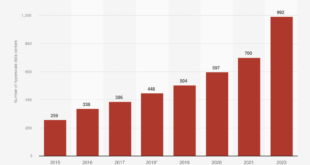Investors have questions about how a new Federal Reserve rate-cutting cycle will affect the biggest US banks, and they will be looking for some answers as third-quarter earnings season begins Friday.
First up are results from JPMorgan Chase (JPM) and Wells Fargo (WFC), followed by Bank of America (BAC) and Citigroup (C) next week.
All four of those big banks are expected by analysts to report that their net profits fell when compared with the prior quarter and the year-ago period, as elevated rates in place for most of the third quarter chipped away at lending margins.
But after the Fed cut its benchmark rate by a half-percentage point on Sept. 18, with more reductions expected this year and next, the more important question for many investors is what happens to future margins as borrowing costs start to drop.
The biggest institutions are already lowering how much they charge new borrowers, cutting into a key source of interest income that boosted profits in 2022 and 2023 as the Fed pushed rates higher.
But there is also a good chance they won’t have to pay as much to retain their customer deposits, which could lower their costs and boost margins over time.
How all of this plays out is still a big unknown, and investors will be listening this week and next for any changes to future outlooks based on the Fed’s new rate path.
“I sense a little anxiety about full-year trends and just how the banks will contend with a swift movement in rates,” Scott Siefers, a managing director and equity analyst for Piper Sandler, told Yahoo Finance.
‘Over-earning’
The key metric to watch will be net interest income, which measures the difference between how much banks earn on their assets versus what they pay for deposits. And the spotlight, as always, will be on JPMorgan, the industry’s biggest bank.
JPMorgan churned out record profits in 2023 as the Fed pushed rates higher to cool inflation, and its stock is up more than 24% so far this year — outperforming most of its rivals.
But there have been signs in recent quarters that its net interest income is coming under new pressure as deposit costs rise. And executives have been trying to reset Wall Street’s expectations, warning that the bank has been “over-earning.”
As recently as last month, JPMorgan COO Daniel Pinto cautioned investors that the consensus view among analysts for the bank to bring in net interest income of $91.5 billion in 2025 was “not very reasonable” due partly to the timing and effect of falling interest rates.
“The [net interest income] expectations are a bit too high,” Pinto said, while speaking at a Barclays conference.
JPMorgan’s stock fell the most intraday since 2020 following Pinto’s comments.
Some analysts are adjusting their views on JPMorgan now that rates are moving down. Last week Morgan Stanley analysts downgraded JPMorgan from overweight to equal weight and said the New York lender was expected to benefit the least among peers from falling rates next year.
“We see less positive surprises ahead for JPMorgan following a strong run over the last two years,” Morgan Stanley’s Betsy Graseck wrote in a note.
Because JPMorgan’s stock did so well as the Fed tightened, that leaves it with less room for upside when compared with rivals now that the Fed is easing, she added.
One vulnerability for JPMorgan and other big banks is that floating rate loans that brought in more interest income as rates surged will now reprice lower.
Another is that because these same giants didn’t have to raise their deposit rates as high as regional banks during the Fed’s tightening cycle, they now stand to benefit less immediately from cheaper funding, according to Moody’s Ratings senior vice president David Fanger.
“Our view is deposit costs will be slower to reprice than floating rate assets,” Fanger told Yahoo Finance. “But over time, we think deposit pricing will catch up.”
It is a challenge for any bank to lower certain deposit costs quickly at the beginning of a Fed cutting cycle.
That is especially true when it comes to longer duration CDs and higher yield savings accounts offered with so-called “exception pricing,” said Korrynn Baltzersen, head of wealth at deposit advisory firm Curinos.
But there is evidence that some rates are starting to come down.
Of the 500 US banks Curinos tracks, 78% of those institutions who had priced CDs above 4.00% have reduced their rates since the Fed’s Sept. 18 rate cut.
Of the lenders that had priced savings and money market deposit accounts above 4.00%, 50% have also reduced their rates, according to Curinos.
‘These high rates have kind of worn out their welcome’
The lenders that stand to benefit most as these deposit rates fall back are the smaller regional banks that saw their funding costs jump after the failures of Silicon Valley Bank and several other sizable institutions in 2023.
For those lenders “there’s going to be a little bit of a mean reversion,” as rates come down, said Chris McGratty, head of US bank research for KBW.
Based on analysis by KBW, earnings growth for large regional lenders is expected to catch up to their bigger peers over the next year while small and mid-sized banks should also see a boost.
“Rate cuts are more positive for mid-cap banks,” Grasek of Morgan Stanley said in a note last week.
Keycorp (KEY) and PNC (PNC) are among those that stand to benefit the most, according to Morgan Stanley’s analysis.
But many investors are still willing to bet lower interest rates may ultimately be a great thing for the entire banking industry, especially if the US economy avoids a recession and lenders can avoid big losses on soured loans.
The monetary policy easing could spur more dealmaking, which helps banks with big investment banking operations, while also boosting demand for new loans from consumers and businesses.
“We’re looking at an interest rate scenario here that is going to be beneficial for banks and beneficial for the market,” Argus Research director Stephen Biggar told Yahoo Finance.
“These high rates have kind of worn out their welcome.”
David Hollerith is a senior reporter for Yahoo Finance covering banking, crypto, and other areas in finance.
Click here for in-depth analysis of the latest stock market news and events moving stock prices.
Read the latest financial and business news from Yahoo Finance
Source link
 meganwoolsey Home
meganwoolsey Home



